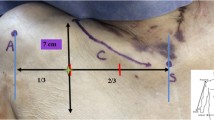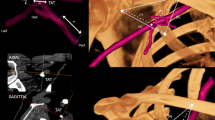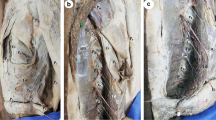Abstract
The patterns of the feeding vessels to each muscle determine the extent of their safe transposition and the muscle’s value as a pedicled flap in reconstructive surgery. This study aimed to demonstrate the point of origin and the intra- and submuscular course of the pectoral branch of the thoracoacromial trunk (TAT) for pectoralis major (PM) flap surgery. Seventy sides of the PM were dissected based on a clinical reference line that has been used for several decades. The branching point of the TAT from the axillary artery was located lateral to the midclavicular line on the right-sided specimens (100%) and medial to the midclavicular line on the left sides (86%). The branching patterns of the pectoral branch to the PM muscle from the TAT were classified into three types. In type I the pectoral branches originated directly from the TAT (55 cases, 78.6%). In type II (11 cases, 15.7%) and type III (4 cases, 5.7%) the pectoral branch divided from the medial and lateral pedicle of the TAT, respectively. The course of the pectoral branch from the TAT in the PM was categorized into three patterns according to the degree of proximity to the midclavicular line. In 49 cases (70%), the pectoral branch in the PM ran within 1 cm of the midclavicular line. The other cases ran 2 cm (20 cases, 29%) and 3 cm (1 case, 1%) from the midclavicular line, respectively. These results provide topographic data of the pectoral branch based on anatomical landmarks, and will be useful in surgical planning as well as the procedure for PM flap surgery.



Similar content being viewed by others
References
Ariyan S (1979) The pectoralis major myocutaneous flap: a versatile flap for reconstruction in the head and neck. Plast Reconstr Surg 63:73–81
Freeman JL, Walker EP, Wilson JSP, Shaw HJ (1981) The vascular anatomy of the pectoralis major myocutaneous flap. Br J Plast Surg 34:3–10
Friedrich W, Lierse W, Herberhold C (1988) Myocutaneous vascular territory of the thoracoacromial artery. A topographical and morphometric study of the arterial vascularization of the pectoralis major myocutaneous flap. Acta Anat 131:284–291
Liu R, Gullane P, Brown D, Irish J (2001) Pectoralis major myocutaneous pedicled flap in head and neck resection: retrospective review of indications and results in 244 consecutive cases at Toronto General Hospital. J Otolaryngol 30:34–40
Manktelow RT, McKee NH, Vettese T (1980) An anatomical study of the pectoralis major muscle as related to functioning free muscle transplantation. Plast Reconstr Surg 65:610–615
Moloy PJ, Gonzales FE (1986) Vascular anatomy of the pectoralis major myocutaneous flap. Arch Otolaryngol Head Neck Surg 112:66–69
Moore KL (1999) Clinically oriented anatomy, 4th edn. Williams & Wilkins, Baltimore, pp 143–149
Nakajima K, Ide Yu, Abe S, Okada M, Kikuchi A, Ide Yo (1997) Anatomical study of the pectoral branch of thoracoacromial artery. Bull Tokyo Dent Coll 38:207–215
Pandey SK, Tripathi FM, Shukla VK, Tripathi CB, Sonoo J, Shukla CB (1991) Anatomical basis for clinical application of the arterial supply of musculus pectoralis major. Acta Anat 141:302–306
Reid CD, Taylor GI (1984) The vascular territory of the acromiothoracic axis. Br J Plast Surg 37:194–212
Wei WI, Lam KH, Wong J (1984) The true pectoralis major myocutaneous island flap: an anatomical study. Br J Plast Surg 37:568–573
Williams PL, Bannister LH, Berry MB, Collins P, Dyson M, Dussek JE, Ferguson MWJ (1995) Gray’s anatomy, 38th edn. Churchill Livingstone, Baltimore, pp 1537–1538
Yang D, Marshall G, Morris SF (2003) Variability in the vascularity of the pectoralis major muscle. J Otolaryngol 32:12–15
Acknowledgements
This study was supported by a grant of the Korea Health 21 R&D Project, Ministry of Health & Welfare, Republic of Korea (02-PJ1-PG1-CH07–0001). We would like to express our thanks to Ms. Seung Hye Kim, a student at the dental college of Yonsei University, for reviewing this article.
Author information
Authors and Affiliations
Corresponding author
Additional information
H.-D. Park and Y.-S. Min equally contributed to this study
Rights and permissions
About this article
Cite this article
Park, HD., Min, YS., Kwak, HH. et al. Anatomical study concerning the origin and course of the pectoral branch of the thoracoacromial trunk for the pectoralis major flap. Surg Radiol Anat 26, 428–432 (2004). https://doi.org/10.1007/s00276-004-0273-8
Received:
Accepted:
Published:
Issue Date:
DOI: https://doi.org/10.1007/s00276-004-0273-8




